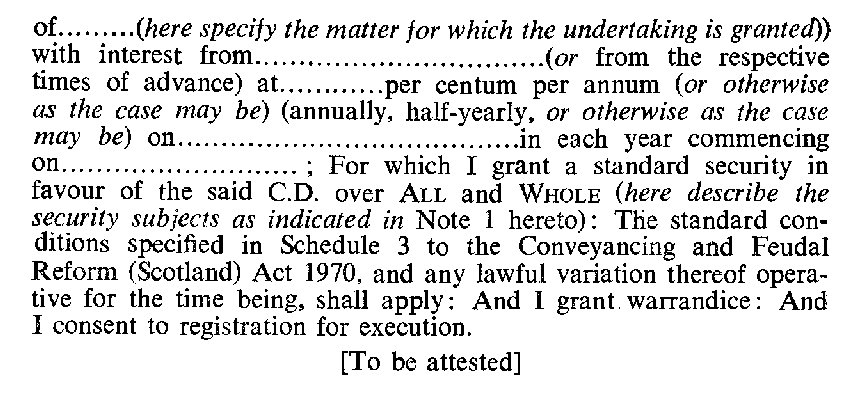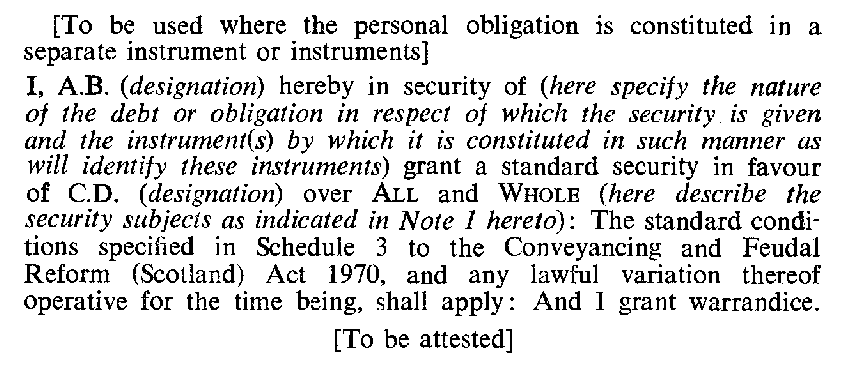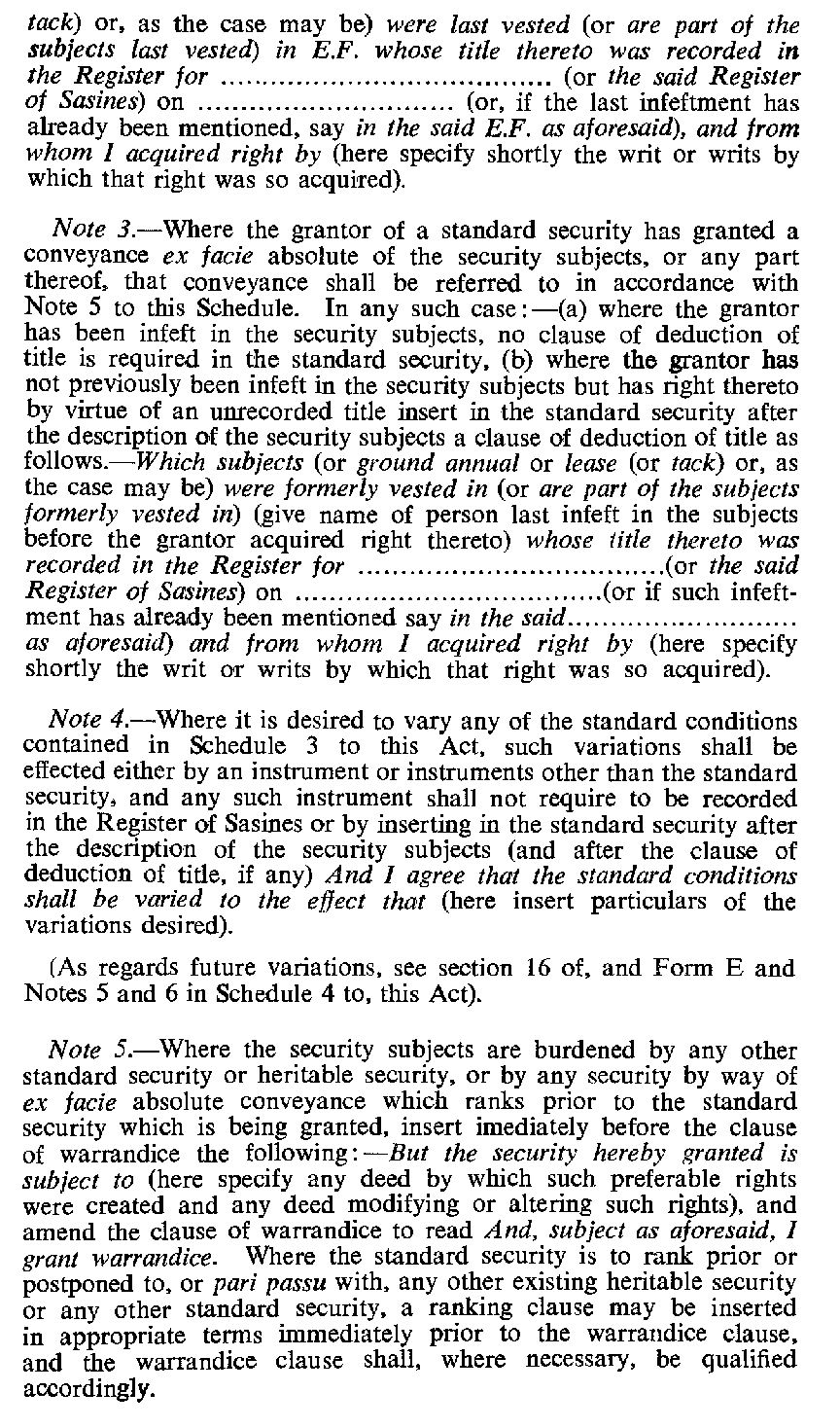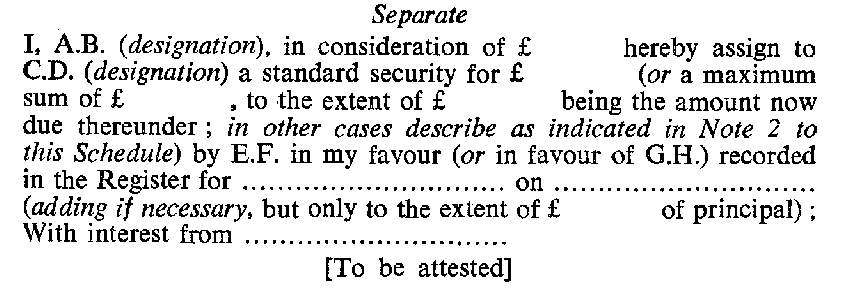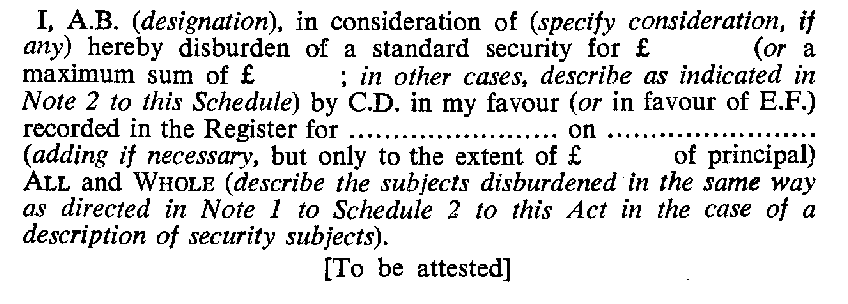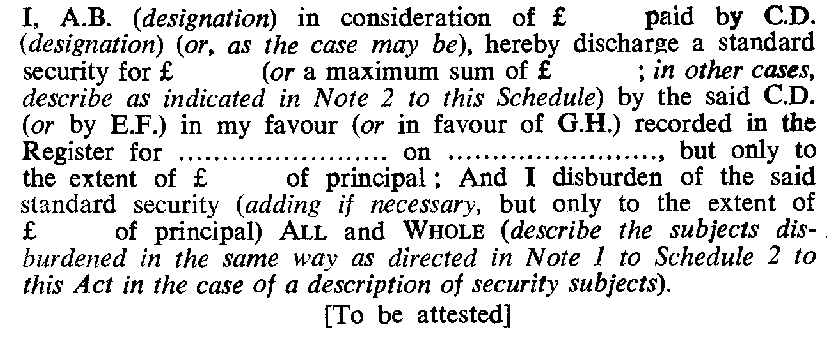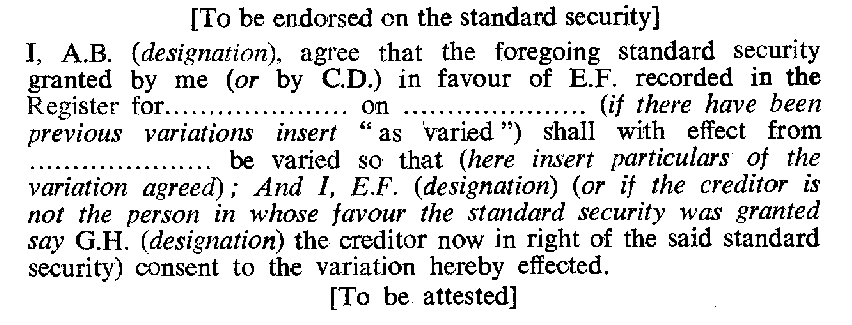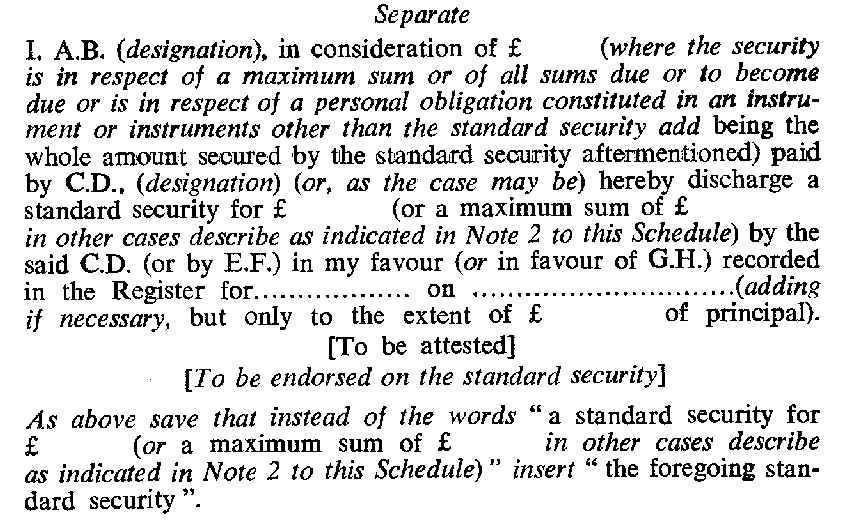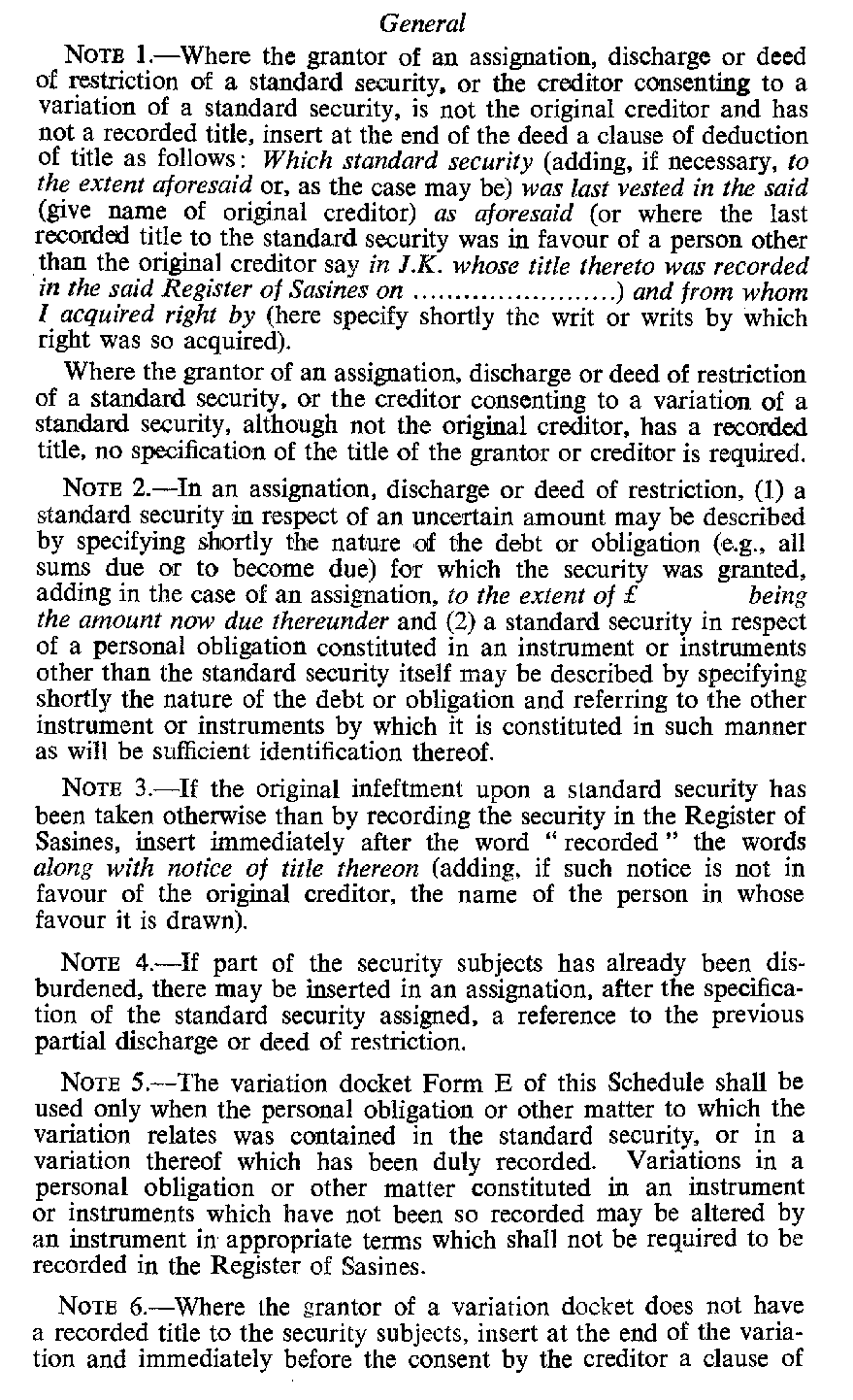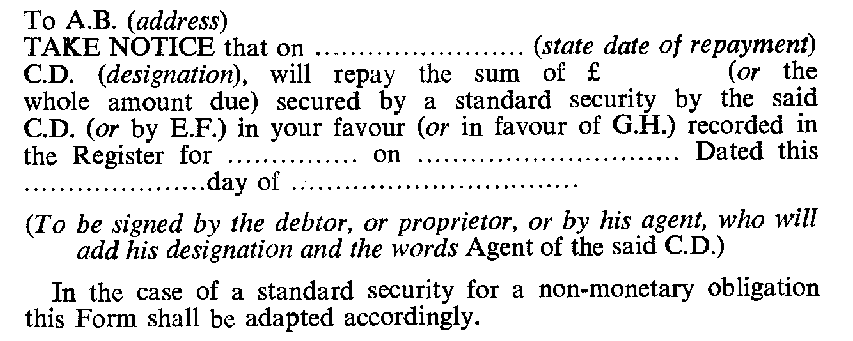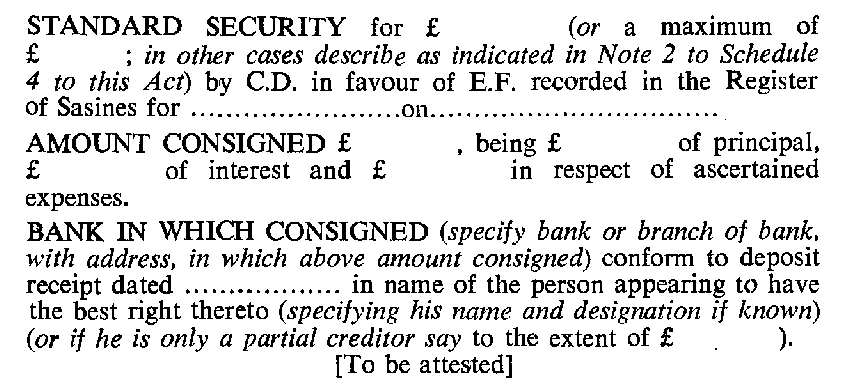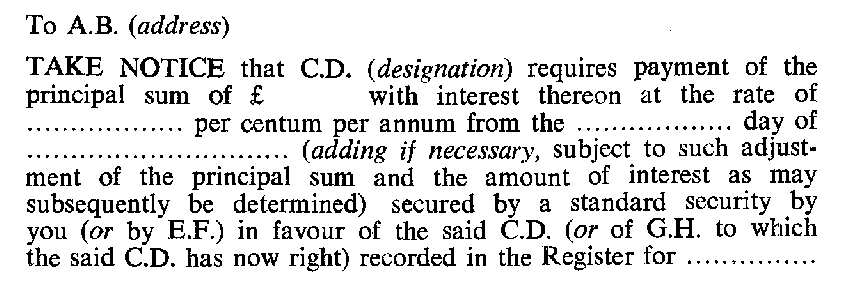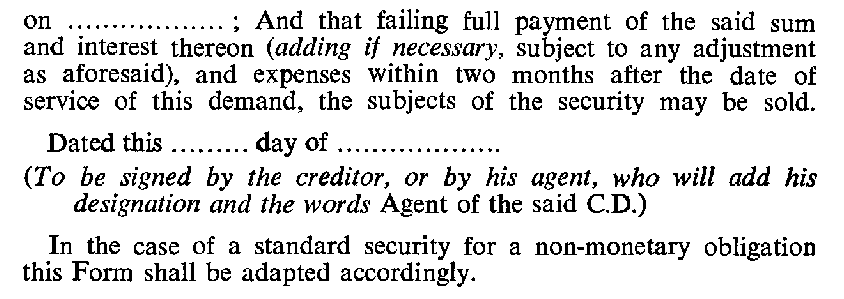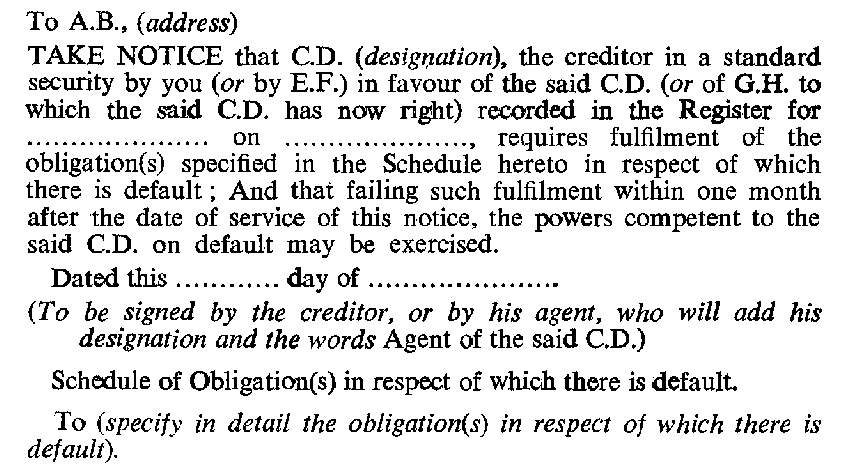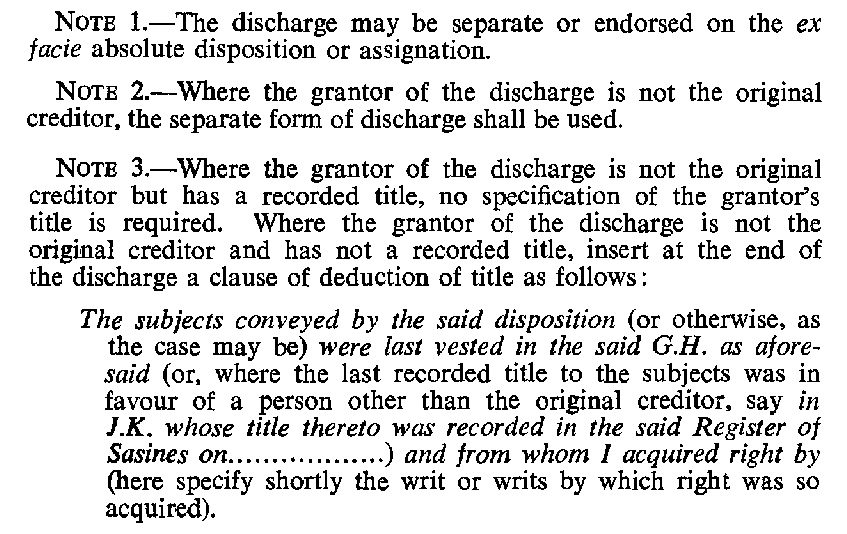- Latest available (Revised)
- Original (As enacted)
Conveyancing and Feudal Reform (Scotland) Act 1970
You are here:
- UK Public General Acts
- 1970 c. 35
- Schedules only
More Resources
Status:
This is the original version (as it was originally enacted).
SCHEDULES
Section 1.
SCHEDULE 1Land obligations not subject to variation or discharge under section 1
1An obligation to pay feuduty, ground annual, rent, skat, dry multure, teind, stipend, standard charge or other payment of a like nature, or an obligation of relief relating to any such payment.
2An obligation, however constituted, relating to the right to work minerals or to any ancillary right in relation to minerals within the meaning of section 2 of the [1966 c. 4.] Mines (Working Facilities and Support) Act 1966.
3An obligation imposed by or on behalf of the Crown for the protection of any royal park, garden or palace.
4An obligation created or imposed—
(i)for naval, military or air force purposes;
(ii)for civil aviation purposes under the powers conferred by section 19 or 23 of the [1949 c. 67.] Civil Aviation Act 1949 or any enactment replaced thereby:
Provided that this paragraph—
(i)shall exclude the application of section 1 of this Act to an obligation falling within sub-paragraph (i) above, and not created or imposed in connection with the use of any land as an aerodrome, only so long as the obligation is enforceable by or on behalf of the Crown; and
(ii)shall exclude the application of section 1 of this Act to an obligation falling within sub-paragraph (ii) above, or created or imposed in connection with the use of any land as an aerodrome, only so long as the obligation is enforceable by or on behalf of the Crown or any public or international authority.
5An obligation created or imposed in or in relation to a lease of—
(a)an agricultural holding, within the meaning of the [1949 c. 75.] Agricultural Holdings (Scotland) Act 1949;
(b)a holding, within the meaning of the Small Landholders (Scotland) Acts 1886 to 1931; or
(c)a croft, within the meaning of the [1955 c. 21.] Crofters (Scotland) Act 1955.
Sections 9 and 10.
SCHEDULE 2Forms of Standard Security
Section 11.
SCHEDULE 3The Standard Conditions
Maintenance and repair.
1It shall be an obligation on the debtor—
(a)to maintain the security subjects in good and sufficient repair to the reasonable satisfaction of the creditor ;
(b)to permit, after seven clear days notice in writing, the creditor or his agent to enter upon the security subjects at all reasonable times to examine the condition thereof;
(c)to make all necessary repairs and make good all defects in pursuance of his obligation under head (a) of this condition within such reasonable period as the creditor may require by notice in writing.
Completion of buildings etc. and prohibition of alterations etc.
2It shall be an obligation on the debtor—
(a)to complete, as soon as may be practicable, any unfinished buildings and works forming part of the security subjects to the reasonable satisfaction of the creditor ;
(b)not to demolish, alter or add to any buildings or works forming part of the security subjects, except in accordance with the terms of a prior written consent of the creditor and in compliance with any consent, licence or approval required by law ;
(c)to exhibit to the creditor at his request evidence of that consent, licence or approval.
Observance of conditions in title, payment of duties, charges, etc., and general compliance with requirements of law relating to security subjects.
3It shall be an obligation on the debtor—
(a)to observe any condition or perform any obligation in respect of the security subjects lawfully binding on him in relation to the security subjects ;
(b)to make due and punctual payment of any ground burden, teind, stipend, or standard charge, and any rates, taxes and other public burdens, and any other payments exigible in respect of the security subjects ;
(c)to comply with any requirement imposed upon him in relation to the security subjects by virtue of any enactment.
Planning notices, etc.
4It shall be an obligation on the debtor—
(a)where he has received any notice or order, issued or made by virtue of the Town and Country Planning (Scotland) Acts 1947 to 1969 or any amendment thereof, or any proposal so made for the making or issuing of any such notice or order, or any other notice or document affecting or likely to affect the security subjects, to give to the creditor, within fourteen days of the receipt of that notice, order or proposal, full particulars thereof ;
(b)to take, as soon as practicable, all reasonable or necessary steps to comply with such a notice or order or, as the case may be, duly to object thereto ;
(c)in the event of the creditor so requiring, to object or to join with the creditor in objecting to any such notice or order or in making representations against any proposal therefor.
Insurance.
5It shall be an obligation on the debtor—
(a)to insure the security subjects or, at the option of the creditor, to permit the creditor to insure the security subjects in the names of the creditor and the debtor to the extent of the market value thereof against the risk of fire and such other risks as the creditor may reasonably require;
(b)to deposit any policy of insurance effected by the debtor for the aforesaid purpose with the creditor;
(c)to pay any premium due in respect of any such policy, and, where the creditor so requests, to exhibit a receipt therefor not later than the fourteenth day after the renewal date of the policy ;
(d)to intimate to the creditor, within fourteen days of the occurrence, any occurrence which may give rise to a claim under the policy, and to authorise the creditor to negotiate the settlement of the claim;
(e)without prejudice to any obligation to the contrary enforce able against him, to comply with any reasonable requirement of the creditor as to the application of any sum received in respect of such a claim ;
(f)to refrain from any act or omission which would invalidate the policy.
Restriction on letting.
6It shall be an obligation on the debtor not to let, or agree to let, the security subjects, or any part thereof, without the prior consent in writing of the creditor, and " to let" in this condition includes to sub-let.
General power of creditor to perform obligations etc. on failure of debtor and power to charge debtor.
7(1)The creditor shall be entitled to perform any obligation imposed by the standard conditions on the debtor, which the debtor has failed to perform.
(2)Where it is necessary for the performance of any obligation as aforesaid, the creditor may, after giving seven clear days notice in writing to the debtor, enter upon the security subjects at all reasonable times.
(3)AH expenses and charges (including any interest thereon), reasonably incurred by the creditor in the exercise of a right conferred by this condition, shall be recoverable from the debtor and shall be deemed to be secured by the security subjects under the standard security, and the rate of any such interest shall be the rate in force at the relevant time in respect of advances secured by the security, or, where no such rate is prescribed, shall be the bank rate in force at the relevant time.
Calling-up.
8The creditor shall be entitled, subject to the terms of the security and to any requirement of law, to call-up a standard security in the manner prescribed by section 19 of this Act.
Default.
9(1)The debtor shall be held to be in default in any of the following circumstances, that is to say—
(a)where a calling-up notice in respect of the security has been served and has not been complied with ;
(b)where there has been a failure to comply with any other requirement arising out of the security ;
(c)where the proprietor of the security subjects has become insolvent.
(2)For the purposes of this condition, the proprietor shall be taken to be insolvent if—
(a)he has become notour bankrupt, or he has executed a trust deed for behoof of, or has made a composition contract or arrangement with, his creditors ;
(b)he has died and a judicial factor has been appointed under section 163 of the [1913 c. 20.] Bankruptcy (Scotland) Act 1913 to divide his insolvent estate among his creditors, or an order has been made for the administration of his estate according to the law of bankruptcy under section 130 of the [1914 c. 59.] Bankruptcy Act 1914, or by virtue of an order of the Court his estate is being administered in accordance with the rules set out in Part I of Schedule 1 to the [1925 c. 23.] Administration of Estates Act 1925 ;
(c)where the proprietor is a company, a winding-up order has been made with respect to it, or a resolution for voluntary winding-up (other than a members' voluntary winding-up) has been passed with respect to it, or a receiver or manager of its undertaking has been duly appointed, or possession has been taken, by or on behalf of the holders of any debentures secured by a floating charge, of any property of the company comprised in or subject to the charge.
Rights of creditor on default.
10(1)Where the debtor is in default, the creditor may, without prejudice to his exercising any other remedy arising from the contract to which the standard security relates, exercise, in accordance with the provisions of Part II of this Act and of any other enactment applying to standard securities, such of the remedies specified in the following sub-paragraphs of this standard condition as he may consider appropriate.
(2)He may proceed to sell the security subjects or any part thereof.
(3)He may enter into possession of the security subjects and may receive or recover feuduties, ground annuals or, as the case may be, the rents of those subjects or any part thereof.
(4)Where he has entered into possession as aforesaid, he may let the security subjects or any part thereof.
(5)Where he has entered into possession as aforesaid there shall be transferred to him all the rights of the debtor in relation to the granting of leases or rights of occupancy over the security subjects and to the management and maintenance of those subjects.
(6)He may effect all such repairs and may make good such defects as are necessary to maintain the security subjects in good and sufficient repair, and may effect such reconstruction, alteration and improvement on the subjects as would be expected of a prudent proprietor to maintain the market value of the subjects, and for the aforesaid purposes may enter on the subjects at all reasonable times.
(7)He may apply to the court for a decree of foreclosure.
Exercise of right of redemption.
11(1)The debtor shall be entitled to exercise his right of redemption under this Act on giving two months' notice of his intention so to do, being a notice in writing (hereinafter referred to as a " notice of redemption ").
(2)Nothing in the provisions of the foregoing sub-paragraph shall preclude a creditor from waiving the necessity for a notice of redemption, or from agreeing to a period of notice of less than two months.
(3)(a)A notice of redemption may be delivered to the creditor or sent by registered post or recorded delivery to him at his last known address, and an acknowledgment signed by the creditor or his agent or a certificate of postage by the person giving the notice accompanied by the postal receipt shall be sufficient evidence of such notice having been given.
(b)If the address of the creditor is not known, or if the packet containing the notice of redemption is returned to the sender with intimation that it could not be delivered, a notice of redemption may be sent to the Extractor of the Court of Session and an acknowledgment of receipt by him shall be sufficient evidence of such notice having been given.
(c)A notice of redemption sent by post shall be held to have been given on the day next after the day of posting.
(4)When a notice of redemption states that a specified amount will be repaid, and it is subsequently ascertained that the whole amount due to be repaid is more or less than the amount specified in the notice, the notice shall nevertheless be effective as a notice of repayment of the amount due as subsequently ascertained.
(5)On payment of the whole amount due, or on performance of the whole obligations of the debtor under the contract to which the security relates, the creditor shall grant a discharge in the terms prescribed in section 17 of this Act.
12The debtor shall be personally liable to the creditor for the whole expenses of the preparation and execution of the standard security and any variation, restriction and discharge thereof and, where any of those deeds are recorded, the recording thereof, and all expenses reasonably incurred by the creditor in calling-up the security and realising or attempting to realise the security subjects, or any part thereof, and exercising any other powers conferred upon him by the security.
Interpretation
In this Schedule, where the debtor is not the proprietor of the security subjects, " debtor " means " proprietor ", except
(a)in standard conditions 9(1), 10(1) and 12, and
(b)in standard condition 11, where "debtor" includes the proprietor.
Sections 14, 15, 16 and 17.
SCHEDULE 4Forms of Deeds of Assignation, Restriction, &c
Section 18.
SCHEDULE 5Procedures as to Redemption
FORM DNO. 1
CERTIFICATE OF CONSIGNATION ON REDEMPTION OF STANDARD SECURITY WHERE DISCHARGE CANNOT BE OBTAINED
NO. 2
CERTIFICATE OF DECLARATOR OF PERFORMANCE OF DEBTOR'S OBLIGATIONS UNDER STANDARD SECURITY WHERE DISCHARGE CANNOT BE OBTAINED
Sections 19 and 21.
SCHEDULE 6Procedures as to Calling-up and Default
Sections 22 and 24.
SCHEDULE 7Contents of Certificate Stating a Default
1A certificate which is lodged in court by the creditor for the purposes of section 22 or 24 of this Act shall contain the information required by the following provisions of this Schedule.
2A certificate shall state—
(i)the name and address of the creditor and shall specify the standard security in respect of which the default is alleged to have occurred by reference to the original creditor and debtor therein and to the particulars of its registration ;
(ii)the nature of the default with full details thereof.
3The certificate shall be signed by the creditor or his solicitor, and a certificate which does not comply with the foregoing requirements of this Schedule shall not be received in evidence for the purposes of the said section 22 or 24.
Section 32.
SCHEDULE 8Excluded Enactments
The [1856 c. 91.] Debts Securities (Scotland) Act 1856
1Section 7 (Securities for cash accounts or credits).
[1857 c. 26.] Registration of Long Leases (Scotland) Act 1857
2Section 4 (Assignations in security).
3Section 5 (Instrument to be expeded where party presenting assignation in security for registration is not original lessee or assignee) so far as affecting assignations in security.
4Section 6 (Translation of assignations in security and creditor's entry on possession in default of payment), so far as relating to such a translation.
5Section 13 (Renunciations and discharges to be recorded) so far as affecting discharges.
6Section 20 (Interpretation of clauses in Schedules).
The [1868 c. 101.] Titles to Land Consolidation (Scotland) Act 1868
7Sections 118 (Form of bond and disposition in security).
8Section 119 (Explanation of clauses in Schedule (FF) No. 1—Form of a Bond and Disposition in Security).
9Section 121 (Validity of sale to purchaser).
10Section 122 (Creditors selling to count and reckon for the surplus of the price and to consign the same in the bank).
11Section 123 (Disburdening of lands on sale and after consignation of surplus price).
12Section 124 (Prescription of form of transfer of securities).
13Section 132 (Renunciation or discharge of heritable security).
14Section 133 (Restriction of heritable security).
15Section 138 (Use of short clauses of consent to registration).
[1874 c. 94.] Conveyancing (Scotland) Act 1874
16Section 48 (Disburdening of lands sold under heritable securities when no surplus emerges).
17Section 49 (Disburdening of lands where debtor in a heritable security cannot obtain discharge owing to the death or absence of the creditor, or any other cause).
The [1894 c. 44.] Heritable Securities (Scotland) Act 1894
18Section 6 (Power of creditor to lease security subjects for seven years or under).
19Section 7 (Granting of power by sheriff to lease security subjects for period of more than seven years).
20Section 8 (Foreclosure).
21Section 9 (Completion of title of security holders and preservation of personal obligation of debtor so far as not extinguished by price on sale of land).
22Section 10 (Purchaser's title indefeasible).
23Section 12 (Procedure).
24Section 15 (Jurisdiction of sheriff).
The [1924 c. 27.] Conveyancing (Scotland) Act 1924
25Section 24 (Assimilation of forms for registered leases).
26Section 25 (Form of bond and disposition in security).
27Sections 28 to 30 (Provisions dealing with the assignation, discharge and restriction of bond and disposition in security).
28Section 31 (Description of lands and deduction of title unnecessary in certain deeds).
29Section 32 (Redemption of bond and disposition in security).
30Sections 33-39 (Provisions relating to calling up bond and disposition in security and advertisement and exposure to sale of the land).
31Section 42 (Mode of disburdening land sold by creditor under power of sale).
Section 40.
SCHEDULE 9Discharge of Heritable Security Constituted by Ex Facie Absolute Conveyance
Sections 47 and 52.
SCHEDULE 10Minor and Consequential Amendments
PART IAmendments affecting specification of title
THE [1857 c. 26.] REGISTRATION OF LEASES (SCOTLAND) ACT 1857
1In Schedule (H), in the footnote, for the words " here state his title and date of recording the same " there shall be substituted the words " name and design original creditor ".
THE [1924 c. 27.] CONVEYANCING (SCOTLAND) ACT 1924
2In Schedule J, in Note 3, for the words from " insert " to the end there shall be substituted the words " no specification of the granter's title is required.".
3In Schedule K, in Note 2, for the words from " insert " to " say " (where the word first occurs) there shall be substituted the words " no specification of the granter's title is required; or if such granter has not a recorded title, insert at the end of the deed Which bond and disposition in security (adding, if necessary, to the extent aforesaid or as the case may be) ".
PART IIOther amendments
THE CONVEYANCING (SCOTLAND) ACT 1924
4In Schedule 1, in the note, before the words " the prior pages thereof" there shall be inserted the words " (in the case of a will or other testamentary writing) ".
THE [1963 c. 51.] LAND COMPENSATION (SCOTLAND) ACT 1963
5In section 10, for the words " Lord President of the Court of Session " there shall be substituted the words " Secretary of State ".
Sections 47, 48 and 52.
SCHEDULE 11Enactments Repealed
PART IRepeals affecting specification of title
| Chapter | Short Title | Extent of Repeal |
|---|---|---|
| 1857 c. 26. | The Registration of Leases (Scotland) Act 1857. | In Schedule (A), the words " [and (when the assigner is not the grantee in the lease) my title to which is recorded in the said register, of date ] ". |
| In Schedule (B), the words " and [where cedent not the original lessee) my title to which is registered therein [date of recording] ". | ||
| In Schedule (1)), the words " [and (if the granter is not the assignee in said bond) my title to which bond and assignation in security is recorded in the said register (date of recording)] ". | ||
| In Schedule (G), the words " and [where the party renouncing not the original lessee] my title to which is recorded in the said register on [date]". |
PART IIRepeals relating to assignations of unrecorded conveyances etc.
| Chapter | Short Title | Extent of Repeal |
|---|---|---|
| 1868 c. 101. | The Titles to Land Consolidation (Scotland) Act 1868. | Section 22. |
| Schedule (M). | ||
| 1924 c. 27. | The Conveyancing (Scotland) Act 1924. | Section 7. |
| In section 10(4), the words " along with a separate assignation or separate assignations, or " and the words " on such separate assignation or on the last in date of such separate assignations or ". | ||
| In section 24, in paragraph (1), the words in brackets. | ||
| In Schedule B, Note 5. | ||
| Schedule C. | ||
| In Schedule F, Note 4, and in Note 5, the words " (with the assignation or assignations, if any, endorsed thereon)", the words " a separate assignation or separate assignations, or along with ", the words " such separate assignation or on the last in date of such separate assignations or on", and the words " adding, if required, and assignation (or assignations) ". |
PART IIIOther repeals
| Chapter | Short Title | Extent of Repeal |
|---|---|---|
| 1857 c. 26. | The Registration of Leases (Scotland) Act 1857. | In section 15, the words from " and extracts of all such writs " to the end of the section. |
| 1868 c. 101. | The Titles to Land Consolidation (Scotland) Act 1868. | In section 142, the words from " and extracts of all such conveyances " to the end of the section. |
| 1924 c. 27. | The Conveyancing (Scotland) Act 1924. | In section 16, subsections (3) and (4). |
| 1925 c. 33. | The Church of Scotland (Property and Endowments) Act 1925. | In section 37, the words from "Provided that" to "either party ". |
| 1949 c. 42. | The Lands Tribunal Act 1949. | In section 8(3), the words from " and the Statutory Instruments Act 1946" to the end of the subsection. |
| 1966 c. 49. | The Housing (Scotland) Act 1966. | Section 189. |
Options/Help
Print Options
PrintThe Whole Act
PrintThe Schedules only
Legislation is available in different versions:
Latest Available (revised):The latest available updated version of the legislation incorporating changes made by subsequent legislation and applied by our editorial team. Changes we have not yet applied to the text, can be found in the ‘Changes to Legislation’ area.
Original (As Enacted or Made): The original version of the legislation as it stood when it was enacted or made. No changes have been applied to the text.
More Resources
Access essential accompanying documents and information for this legislation item from this tab. Dependent on the legislation item being viewed this may include:
- the original print PDF of the as enacted version that was used for the print copy
- lists of changes made by and/or affecting this legislation item
- confers power and blanket amendment details
- all formats of all associated documents
- correction slips
- links to related legislation and further information resources
More Resources
Use this menu to access essential accompanying documents and information for this legislation item. Dependent on the legislation item being viewed this may include:
- the original print PDF of the as enacted version that was used for the print copy
- correction slips
Click 'View More' or select 'More Resources' tab for additional information including:
- lists of changes made by and/or affecting this legislation item
- confers power and blanket amendment details
- all formats of all associated documents
- links to related legislation and further information resources

